NOTE: "Street Fighter Two DASH"—yes, DASH—is the proper, full title for the PCE port.
The Street Fighter II' Poster #3 (2600x1619.jpg) ▼ below reveals that NEC's engineers, as well as its marketing department, played an important role in the launch of Street Fighter II' on PCE.
NEC showcased SFII' at three major trade shows: (1) Tokyo Toy Show '93, (2) NEC PC Fair–Tokyo '93 and (3) PC-Engine World '93.
Street Fighter II' Poster #3. SOURCE: Gekkan PCE #7, July 1993
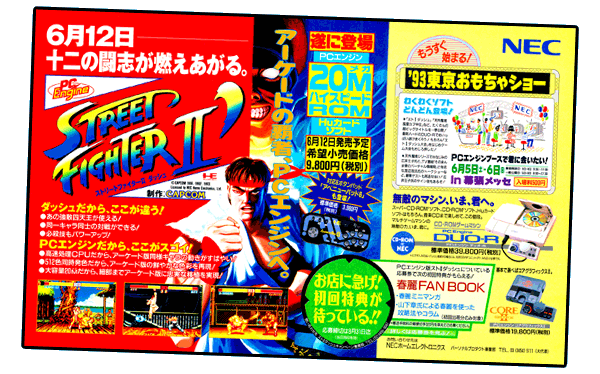
WAIT! THERE ARE MORE…
Street Fighter II' Poster #1. SOURCE: Gekkan PCE #5 (May 1993)
Street Fighter II' Poster #2. SOURCE: Gekkan PCE #6 (June 1993)
Street Fighter II' Poster #3. SOURCE: Gekkan PCE #7 (July 1993)
AT A GLANCE: PCE SFII' TIMELINE
The timeline below provides a quick overview of the SFII' launch—however, for a deeper discussion of how NEC capitalized on the popularity of SFII' in an effort to promote the PCE ecosystem, read the entire article.
SFII' PCE TIMELINE
06.03.93: TOKYO TOY SHOW '93 (¥500). At the Tokyo Toy Show 1993, folks had a chance to see and play many PCE games, including Street Fighter II' before its official release (06.12.93). This four-day event was held from 9:30AM-5:30PM on the first two days (06.03–06.04) and from 9:00AM–5:30PM on the remaining two days (06.04–06.05). A "celebrity" of some sort would be signing autographs on these final two days.
Tokyo Toy Fair '93. SOURCE: Gekkan PCE #7 (July 1993)
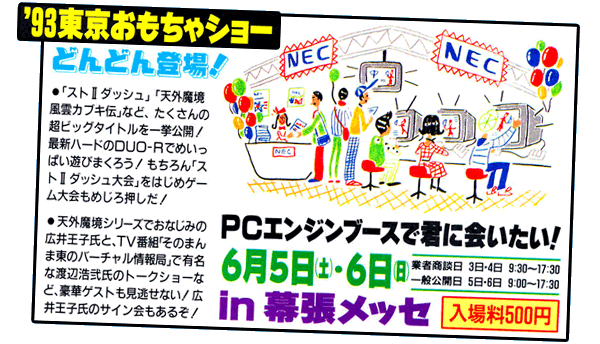
06.12.93: STREET FIGHTER II' (¥9,800). The first and only 20 Meg HuCARD. Packaged in a double jewel case.
06.12.93: AVENUE PAD 6 (¥3,980). Anyone who takes Street Fighter II' seriously will need a 6-button controller.
07.22.93: NEC PC FAIR–TOKYO '93 (Free Admission). At the NEC PC Fair–Tokyo 1993, play Street Fighter II' and other PCE titles. A three-day event held on 07.22–07.24 from 10:00AM–6:00PM. NOTE: The NEC PC FAIR featured NEC's vast catalog of personal computer (PC) products.
NEC PC Fair '93. PC-Engine World '93. SOURCE: Gekkan PCE #8 (August 1993)
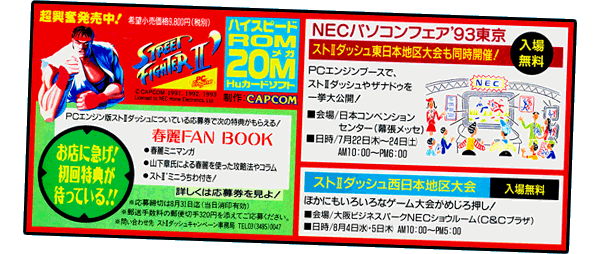
08.04.93: PC-ENGINE WORLD '93 (Free Admission). At PC Engine World 1993, play Street Fighter II' and other PCE titles. A two-day event held on 08.04–08.05 from 10:00AM–5:00PM.
PC-Engine World '93. SOURCE: Gekkan PCE #9 (September 1993)
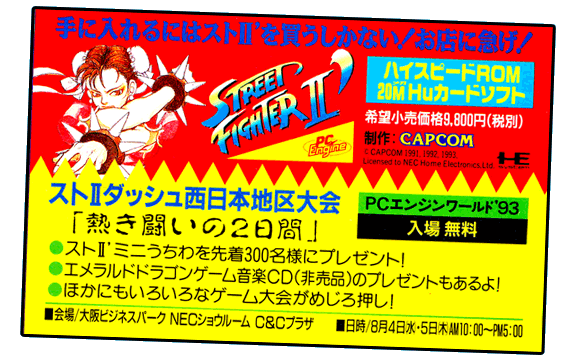
08.31.93: PCE SFII' FAN BOOK (¥320 Postage). An exclusive Chun-Li mini-comic by Akira Yamashita was available in the "first shipment" only (?). Folks could also send away for the comic/fan book (by providing ¥320 postage stamp by 08.31.1993). QUERY: Did this offer expire on 08.31.93?
SFII' FAN BOOK & Chun-Li Mini-Comic. SOURCE: Gekkan PCE #9 (September 1993)

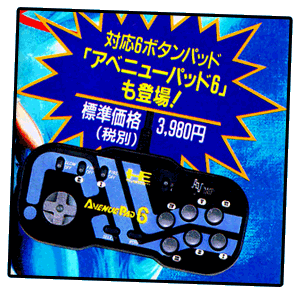 AVENUE PAD 6 (ON TOPIC): As Street Fighter II' ushered in a Golden Age of fighting games, NEC would have been foolish not to release a 6-button controller. Note that the turbo switches (auto-fire) were only available for Button I and II. This wasn't a problem since serious players wouldn't use auto-fire in fighting games. As for other genres, where auto-fire might be desirable (for example, shooters), the only relevant buttons were I and II. Although RUN and/or SELECT served as auxillary buttons in some PCE games, the functions they performed would never require auto-fire.
AVENUE PAD 6 (ON TOPIC): As Street Fighter II' ushered in a Golden Age of fighting games, NEC would have been foolish not to release a 6-button controller. Note that the turbo switches (auto-fire) were only available for Button I and II. This wasn't a problem since serious players wouldn't use auto-fire in fighting games. As for other genres, where auto-fire might be desirable (for example, shooters), the only relevant buttons were I and II. Although RUN and/or SELECT served as auxillary buttons in some PCE games, the functions they performed would never require auto-fire.
AVENUE PAD 3 (AN ASIDE): This wasn't the first time that a specific game prompted NEC to release a customized controller—a year prior (03.27.1992), NEC had released AVENUE PAD 3 for Forgotten Worlds (another Capcom port, coincidentally). Forgotten Worlds (SCD) was released in two retail packages: the standard method (that is, a shrinkwrapped jewel case + OBI) and a special bundle (a large box containing AVENUE PAD 3 + Forgotten Worlds). The RUN or SELECT button could be mapped to BUTTON III on AVENUE PAD 3, providing a more convenient button for rotating weapons in Forgotten Worlds.
NEC FACED CHALLENGES PREPARING FOR SFII'…
Street Fighter II was so popular at this time—the standard reasoning goes—that the HuCARD could have sold itself without any promotion and still make a handsome profit for all parties involved. This was probably true, but it downplays the significant amount of money and resources NEC had invested in PCE Street Fighter II'…
(A) higher production costs for SFII' HuCARD (not simply because each HuCARD required 20Mb ROM, but because engineering and manufacturing processes had to be modified to accommodate a new 20Mb ROM HuCARD);
(B) to be taken seriously, NEC had to release a 6-button controller for SFII' (however, consumers—especially fans of fighting games—can be particularly finicky about controllers, since executing precise maneuvers in a game requires a certain tactile feel and responsiveness from the mechanical components of a control pad. NEC had to design a halfway decent controller, lest third-parties swoop in to grab the market, leaving NEC with a large inventory of unsold stock);
(C) if NEC overestimated demand for either SFII' or AVENUE PAD 6, they would be stuck with a large inventory of unsold stock (compounding the problem is the fact that SFII' was costlier than your average HuCARD, just as AVENUE PAD 6 was costlier than your average controller. Unsold stock is a liability, gathering dust instead of generating revenue).
These issues were not unique to NEC, of course. Any company selling hardware/software faced these challenges, too. I listed them simply to provide context—NEC would have been foolish to simply hope that SFII' and AVENUE PAD 6 sold well.
No, NEC would have to ensure that these products were successful and sold well. How could they achieve this goal? Typical marketing tactics, such as advertising on television and in print media, would not be enough.
NEC'S STRATEGY FOR SUCCESS…
NEC needed SFII' and AVENUE PAD 6 to sell well. The solution? Nothing groundbreaking, sadly. NEC would offer consumers PCE-exclusive items and experiences to make Street Fighter II' appear slightly more "special" than the standard release:
(D) PCE-exclusive SFII' FAN BOOK + Chun-Li Mini-Comic (by Akira Yamashita). The SFII' FAN BOOK fit comfortably inside SFII's double jewel case (there was no need for this jumbo-sized case, but, again, from a marketing perspective, it emphasized SFII's unique status as the first and only 20Mb HuCARD…also, if you are paying ¥9,800 for a HuCARD title, you want to at least feel as if you are getting your money's worth);
(E) Heavily promote SFII' at trade shows (Tokyo Toy Fair, NEC PC Fair, PC Engine World) where folks could play SFII', and other PCE games, before they were officially released to retail channels. Also, these events were perfect opportunities for folks to see if the AVENUE PAD 6 was worth its ¥3,980 pricetag;
(F) DUO-R, a "budget" model. NEC was also hoping that interest in SFII' would be strong enough to drive hardware sales. Released on 03.25.1993, the DUO-R was a "streamlined", lower-priced version of the DUO console (DUO-R launched at ¥39,800, a savings of ¥20,000 off the DUO). In addition, NEC hoped that SFII' would drive sales of the base PCE console (CoreGrafx II). However, NEC did not lower the price of CoreGrafx II! Despite having been on the market for two years, CoreGrafx II (released on 06.21.1991) still retailed for ¥19,800 (its price at launch)! And now NEC hoped that SFII' would help sell even more CoreGrafx II consoles at that price point.
MEANWHILE, IN NORTH AMERICA…
TG-16 fans were eagerly following the PCE launch of Street Fighter II', AVENUE PAD 6, DUO-R, etc. in Japan…
SOURCE: DuoWorld #1 (July/August 1993)
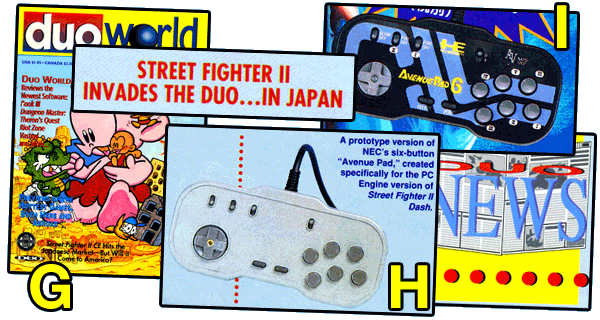
(G) ACROSS THE PACIFIC: The cover of DuoWorld #1 (July/August 1993) magazine asks, "Street Figher II CE Hits the Japanese Market—But Will It Come to America?"
(H) PROTOTYPE: The prototype (white) AVENUE PAD 6 pictured above is nearly identical to (I) the final production model (black), save for an exposed brass bolt anchoring the direction pad on the prototype.
(I) FINAL PRODUCTION MODEL: The retail version of AVENUE PAD 6.
SLIM CHANCE: Of course, SFII' never did make it across the Pacific. TTi certainly was interested, but the licensing fees, localization costs, and sales projections could not justify a stateside release. More importantly, TTi was on death's door at this point and would be out of business in under a year. With all of its financial struggles, TTi was in no position to commit to a high profile, big budget project.
TWO-BUTTONS: Another significant problem facing TTi concerned the control pad—would anyone in North America want SFII' if they could only play it using the standard two-button TG-16 control pad? Was TTi in a financial position to market and distribute a six-button controller for, essentially, a single game in the TG-16 library? TTi had already established a precedent by releasing Forgotten Worlds in North America without AVENUE PAD 3…but Forgotten Worlds played fine with a standard controller, whereas the game mechanics of SFII' really suffered (to the point of being "unacceptable") with a standard controller.
NO CHANCE: Finally, what were the chances that the DUO-R would be released in North America? Well, the truth is that TTi had a stockpile of unsold* DUO consoles sitting in a warehouse—they were certainly not going to release the newer, cheaper DUO-R until they had sold all of the older, more expensive DUO units first.
*When Turbo Zone Direct (tzd.com) acquired all of TTi's old stock (May of 1994), it included DUO consoles. When tzd.com liquidated nearly 14 years later (January of 2008), it included—you guessed it—new old stock (NOS) DUO consoles.
SFII' FAN BOOK + CHUN-LI MINI-COMIC…
DISCLAIMER: Clearly, at this point, I don't even know if the mini-comic was a standalone item or part of the FAN BOOK.
SOURCE: Gekkan PCE #9 (September 1993)

SFII' FAN BOOK: Not sure what comprises the content of the FAN BOOK…was it the size of a standard PCE manual? Two items above are titled "FAN BOOK" (front/back cover? Or, FAN BOOK had alternate cover?)
CHUN-LI MINI-COMIC: An exclusive mini-comic by Akira Yamashita.
NOTES:
?? Without exception, ALL attendees receive SFII' FAN BOOK??
• Information on main characters from game?
• Credits for mini-comic? (Akira Yamashita, Mr. G/Niyomi, who else?)
• SFII' mini-fans (are these limited to 300?)
BOXED NOTES:
1. Of "Pretty single game Sat Seramu Ichin"
2. and NOZUE Kuchi-ko teacher only,
3. Of "Patlabor XXXX"
4. Takada Akemi teacher,
5. Illustrations drawn by two large!
MANY UNANSWERED QUESTIONS: Even if we had the physical items pictured above, not all of our questions would be answered…
(0) Was the Chun-Li mini-comic simply a part of the FAN BOOK?
(1) Requests for fan book/comic had to be postmarked by 08.31.1993? Were any items available via mail-order only?
(2) What is the long, vertical "pamphlet" pictured below?
(3) How were fan book/mini-comic distributed? (Was it distributed at the SFII Special Event? Was this available via mail-order only? Was it included in some retail copies of Street Fighter II'?)
SOURCE: Gekkan PCE #9 (September 1993)

QUERY: Any new information to be gleaned from image above? Or is this the same info provided by the earlier notices?
NOTES:
SFII' Datsushu West District Conference
2 days of "intense competition" (passionate struggle)
• The first 300 people will receive a SFII' mini fan!
• There is also a gift Emerald Dragon Game Music CD (not for sale)!
• In addition to tournament competition! (Over a variety of system tournament jostling In addition to!)
Continued below…
TOP TEN PLUS (VOL.2)…▲
Work in progress…

DETAIL: …
Note the…
▲
Return to top of page…